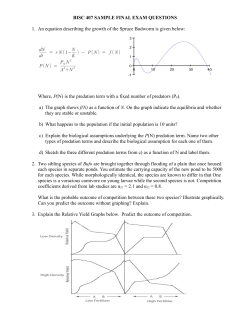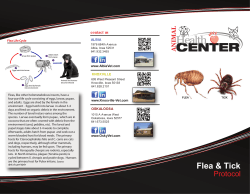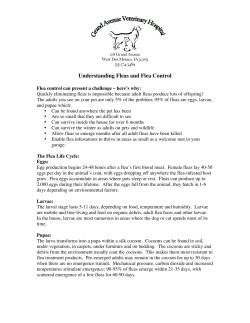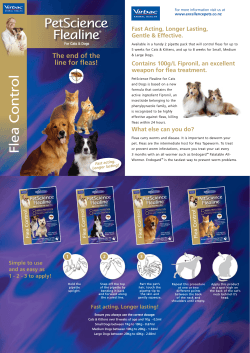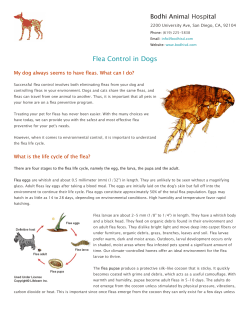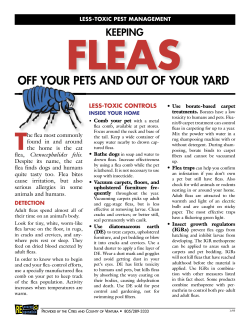
- Feline Specialties Veterinary Hospital
9702 Riverside Dr. (918) 299-8222 April 2015 Flea Round Up Flea Season Traditionally, we have considered spring and summer to be considered as the “flea season”. However, in Oklahoma our winters never get cold enough or are long enough to impact the flea population. In addition, most stages of the flea life cycle happen where our pets live. And for most of us that is inside with us. Therefore, flea season is 12 months long in Oklahoma. Flea Life Cycle The adult flea lives its entire life on the cat (or dog). It will take a blood meal, mate and lay eggs. These eggs along with the flea feces (flea dirt) will then drop out of the fur into the environment. The highest population of flea eggs will be where your cat spends most of its time—its favorite bed, your bed, your couch, etc. The flea egg will hatch out a larvae that then burrows down away from light. The flea larvae then feeds on the flea dirt that is in your carpet or the cat’s (or your) bedding. As the larvae matures, it will form a cocoon or pupae. These pupae have a tough outer shell that is resistant to any chemicals. In addition, these pupae can remain in their cocoons for 6 months or more. After the pupa develops, it does not automatically emerge from its cocoon. It is able to remain in the cocoon until it detects a nearby host. The mature pupa is able to detect the vibrations, heat and carbon dioxide levels of an approaching host. It will emerge from its cocoon and jump onto the host. A common scenario occurs when a cat or dog is boarded during the owner’s vacation. The owner picks up the cat (or dog) from the boarding kennel and returns home. The mature pupae have been waiting for a host and when the cat or dog enters the home, a huge number of adult fleas emerge at once and attack the host creating a sudden, heavy infestation. Often the boarding kennel is blamed for giving the pet fleas. What really happened was that the pupae waited to emerge while there was no host present and then they all emerged at once when the host arrived. ON AVERAGE, THE TIME PERIOD FROM EGG TO ADULT FLEA IS ABOUT 3 WEEKS. A Few Words on Tapeworms There are many species of tapeworms but the one most of us are familiar with is the common tapeworm, Dipylidium caninum. Tapeworms live in the intestinal tract and feed off the ingesta in the intestines. The worm will pass segments filled with eggs with the feces. Often these segments will “hang up” on the fur around the anus or at the anal opening. When “fresh”, these segments are white, flat and 1/4 -1/2inch long. After they dry, they look like dried pieces of rice. These rice-like pieces drop into the environment where they become a tasty treat for flea larvae. They remain in the flea larvae throughout its development into an adult flea. When the flea infected cat grooms itself, it will often swallow the adult flea that is now carrying tapeworm eggs. The tapeworm eggs hatch out in the intestines and begin the life cycle again. Since cats are fastidious groomers, they will often reinfect themselves by ingesting tapeworm segments from their fur or anus during grooming. It is common to see tapeworm infections years after the cat has been flea free. Especially, those cats that are heavy groomers. Fleas Can Kill It would be a mistake to think of the flea as simply a nuisance. A heavy flea burden is lethal, especially to smaller or younger animals. The flea is not at all selective about its host and has been known to kill dairy calves through heavy infestation. Flea infestations can cause the following conditions: Fleas are blood-sucking insects that can cause a slow but still lifethreatening blood loss. This is not only a problem with young kittens but also a problem for elderly cats. Older cats often do not groom well allowing the fleas to feed undisturbed. In addition, older cats often have other debilitating diseases that may slow down the production of replacement red blood cells that are needed. It is important that young kittens and geriatric cats be well protected from fleas. Flea Anemia Feline Infectious Anemia—a Flea Allergic Dermatitis—cats who are allergic to the saliva in a flea bite will scratch and bite themselves causing hair loss, scabs and often large sores. life-threatening blood parasite carried by fleas. Cat Scratch Fever/Bartonellosis—this organism carried by fleas does not make the cat sick but the infected cat can make a person sick. Tapeworm Infection Myths Veterinarians Hear Every Day boards of hardwood floors. My cat cannot have fleas because he lives totally indoors. Fleas thrive particularly well in the well-regulated temperatures in the home. You cannot expect to see fleas as cats are adept at licking them away. More often you will see the secondary signs of flea infestation: My cat cannot have fleas because they are not jumping/ biting us. Though fleas have the ability to feed on a wide variety of hosts, it does not prefer human blood and won’t eat it unless absolutely necessary. A newly emerged adult flea is hungry and may well take a blood meal from the first warm body it finds—human or cat. But in general, adult fleas regard human blood as a last choice and humans tend not to be bitten unless flea population numbers are very high. Fleas love to develop in the cracks between the Specks of flea dirt (feces) on your cat or bedding. Flea dirt looks like—well—dirt but will turn red when wet. After all, it IS digested blood. Areas of thin (or no hair) wherever the cat can reach with its tongue—the rump, flanks and abdomen. Scabs around the neck and face—this is where the cat is scratching at the fleas with its back claws. We do not have fleas because we have only hardwood floors. My cat cannot have fleas be- cause I would see them. Hairballs—with the excess ingestion of hair comes the inevitable—hairballs. Flea Products for Cats Fleas are survivors. With the arrival of insecticides, other products that leave a large oily spot. So far, came flea resistance. The members of the flea popu- we have not seen any flea resistance to Revolution. lation that survived a particular insecticide would pass those genes onto their offspring. The manufacturers It is now recommended to rotate flea products pe- of flea products then turned to stronger insecticides. riodically. Repeated exposure to the same insecti- In addition, dog owners wanted added tick protection. cide will eventually produce a resistant population. Ticks require significantly more lethal insecticides to If you switch to another insecticide, the fleas will kill them than fleas. This created many effective be totally sensitive to the new insecticide. After a products labeled for dogs—not cats. Cats are sensi- few more generations, change again. Up until re- tive to insecticides and the insecticides in many of cently, we had yet to find a product that we felt we these products are at toxic levels for cats. READ LA- could recommend to owners to rotate with Revolu- BELS BEFORE APPLYING FLEA PRODUCTS ON YOUR tion. The products we researched were either too CAT. toxic in cats or had shown flea resistance. We now recommend the Seresto collar for flea control in The doctors at Feline Specialties recommend Revolu- cats 10 weeks and older. It is a flea collar that tion for flea control on cats. Revolution is safe for cats works! Other advantages are that it is odorless and and is labeled for control of fleas, ticks, ear mites, lasts 8 months. For those clients who wish to start heartworms, roundworms and hookworms. It can be a regular rotation of flea products, we will be hap- used in kittens as young as 8 weeks as well as preg- py to place you in our reminder system so your cat nant or nursing cats. Revolution is a topical product will stay protected year round. that is applied to the back of you cat’s neck once a month. It is alcohol based so dries to a powder unlike The Person Behind the Face We would like to introduce our two new “techs in training”. Peyton Edwards (the blonde on the left) was raised on a farm and is currently attending TCC with the hopes of attending vet school soon. She shares her house with 2 former Feline Specialties kittens and “loves getting to spend time with our client’s cats”! Shannon Starkey (the brunette on the right) recently moved back to Oklahoma from Texas. She will be attending Veterinary Technician school at TCC in the fall working towards her CVT (certified veterinary technician) degree. She shares her home with 3 kitties and a dog. Hospital Hours Monday - Friday 7:00am - 6:00pm Saturday 9:00am- noon Sunday 9:00am—9:30am for drop offs and pick ups Contact Information Phone (918) 299-8222 www.felinespecialties.com Fax (918) 299-8199 E-mail for general information: info@felinespecialties.com E-mail for Dr. Zinn: jzinn@felinespecialties.com E-mail for Dr. O’Cain: jocain@felinespecialties.com Emergency Information For after hours emergency contact: Oklahoma Veterinary Specialists (OVS) (918) 299-4900 9360 S Union (west of highway 75 at the Jenks exit) Animal Emergency Clinic (AEC) (918) 665-0508 4055 S 102nd E AVE (west of highway 169 at the 41st Street exit)
© Copyright 2025

